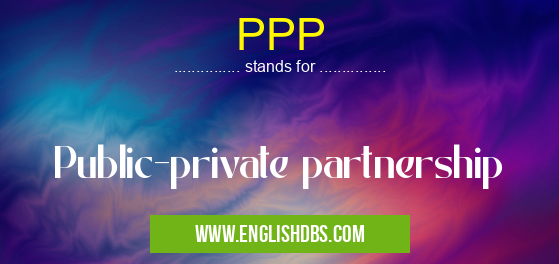What does PPP mean in DEVELOPMENT
PPP stands for Public-Private Partnership, which is a cooperative arrangement between the government and private sector companies to undertake infrastructure and public service projects. PPPs leverage the expertise and resources of both sectors to deliver projects efficiently, cost-effectively, and with reduced risk.

PPP meaning in Development in Community
PPP mostly used in an acronym Development in Category Community that means Public-private partnership
Shorthand: PPP,
Full Form: Public-private partnership
For more information of "Public-private partnership", see the section below.
» Community » Development
Types of PPPs
PPPs can take various forms, including:
- Design-Build-Finance-Operate (DBFO): The private partner designs, builds, finances, and operates the project.
- Build-Own-Operate-Transfer (BOOT): The private partner builds, owns, and operates the project for a period, after which it is transferred to the government.
- Service Contract: The private partner provides specific services related to the project, such as maintenance or operation.
Benefits of PPPs
PPPs offer several advantages over traditional public procurement methods:
- Access to Private Sector Expertise: PPPs allow governments to tap into the specialized skills and experience of private sector companies.
- Risk Sharing: Risks associated with the project are shared between the public and private sectors, mitigating potential financial losses for either party.
- Cost Savings: PPPs can often reduce project costs through improved efficiency, economies of scale, and access to private financing.
- Innovation: Private sector partners bring new technologies and innovative solutions to projects, fostering efficiency and sustainability.
Role of Government in PPPs
The government plays a crucial role in PPPs, responsible for:
- Establishing the Framework: Developing clear policies, regulations, and standards for PPPs.
- Risk Allocation and Mitigation: Ensuring that risks are fairly allocated and mitigated to protect the interests of both parties.
- Monitoring and Evaluation: Monitoring the progress and performance of PPPs to ensure compliance with contractual obligations.
Essential Questions and Answers on Public-private partnership in "COMMUNITY»DEVELOPMENT"
What is a Public-Private Partnership (PPP)?
A PPP is a collaborative venture between a government agency and a private sector company to develop and operate a public infrastructure project. The private sector partner typically provides financing and expertise, while the government agency maintains ownership of the project.
What are the benefits of PPPs?
PPPs offer several benefits, including access to private sector expertise, cost-efficient project delivery, and reduced government financial risk.
What are the different types of PPPs?
There are various types of PPPs, including design-build-finance-operate (DBFO), design-build-operate (DBO), and build-operate-transfer (BOT).
How are PPPs evaluated?
PPPs are typically evaluated based on factors such as project feasibility, financial viability, and environmental sustainability.
What are the key considerations for successful PPPs?
Successful PPPs require clear project objectives, a well-defined risk allocation mechanism, and effective stakeholder management.
What are some examples of PPPs?
PPPs have been used in various infrastructure sectors, including transportation (e.g., roads, bridges), energy (e.g., power plants), and water management (e.g., water treatment facilities).
Are PPPs always the best option for public infrastructure projects?
The suitability of PPPs depends on project-specific factors. Governments should carefully consider the potential benefits and risks before opting for a PPP.
How can PPPs help address infrastructure challenges in developing countries?
PPPs can provide access to private sector expertise and financing, which can be critical for addressing infrastructure gaps in developing countries.
Final Words: PPPs are a valuable tool for governments to attract private sector investment and expertise in delivering essential infrastructure and public services. By leveraging the strengths of both sectors, PPPs enable efficient, cost-effective, and innovative project execution. However, careful planning, risk management, and robust governance frameworks are essential for successful PPP implementation.
